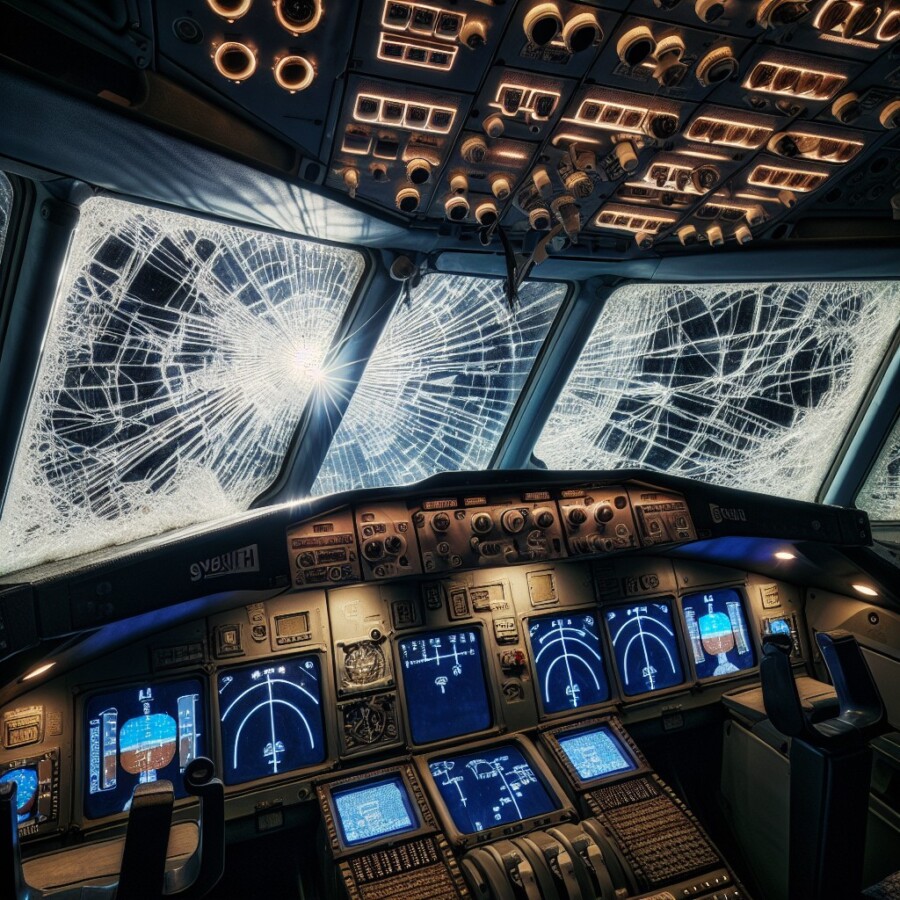A domestic flight operated by All Nippon Airways (ANA) in Japan had to turn back to its departure airport due to a crack in the cockpit window. The crack was found in the outermost layer of the window and did not affect the flight’s control or pressurization. The Boeing 737 aircraft was flying from Sapporo to Toyama when the crack was discovered. There were no injuries reported among the 59 passengers and six crew members on board. ANA, Japan’s largest carrier, stated that the cause of the crack is still unknown.
Aviation expert John Strickland mentioned that incidents like this occasionally occur, possibly due to a bird strike or a hailstone hitting the window. Stress fractures from wear and tear are also rare but can happen. To ensure the safety of the aircraft, it is likely that the entire window will need to be replaced, not just the broken layer. ANA arranged alternative flights for the affected passengers.
It is important to note that this incident is unrelated to the recent grounding of Boeing 737 MAX 9 airplanes. The ANA flight involved an earlier version of the Boeing 737 and was not part of the MAX 9 fleet. The grounding of the MAX 9 planes was initiated by the US aviation regulator, the FAA, after an Alaska Airlines plane experienced a blowout, resulting in a cabin panel falling off mid-air. The FAA has extended the grounding indefinitely for further safety checks and will increase oversight of Boeing.
In conclusion, a crack in the cockpit window forced an ANA flight in Japan to return to its departure airport. The cause of the crack is still unknown, but it did not affect the flight’s control or pressurization. ANA ensured the safety of the passengers by arranging alternative flights. This incident is separate from the grounding of Boeing 737 MAX 9 planes, which was prompted by a different safety issue.
Original news source: Cockpit window crack forces ANA Boeing flight in Japan to turn back (BBC)
🎧 Listen:
Slow
Normal
Fast
📖 Vocabulary:
| 1 | domestic | Relating to the internal affairs of a country |
| 2 | cockpit | The area in an aircraft where the pilot and co-pilot sit to control the vehicle |
| 3 | pressurization | The maintenance of adequate air pressure in an airplane cabin |
| 4 | carrier | A company that provides air transport services for traveling passengers |
| 5 | hailstone | A pellet of frozen rain which falls during a storm |
| 6 | fractures | Breaks or cracks in a material without complete separation of parts |
| 7 | aviation | The design, development, production, operation, and use of aircraft |
| 8 | fleet | A group of vehicles, typically ships or aircraft, operated together under the same ownership |
| 9 | grounding | A temporary suspension of operation, especially of aircraft |
| 10 | regulator | An authority or agency that supervises or controls certain activities |
| 11 | blowout | A sudden and violent release or burst |
| 12 | oversight | Supervision or careful watching over a process or activity |
| 13 | indefinitely | For an unlimited or unspecified period of time |
| 14 | alternative | A substitute or second option |
| 15 | prompted | Caused or brought about by a specific action |
Group or Classroom Activities
Warm-up Activities:
– News Summary
Instructions: Have students work in pairs or small groups. Ask them to read the article and then summarize the main points in their own words. They should focus on the key details and events mentioned in the article. After a designated time, have each group share their summaries with the class.
– Opinion Poll
Instructions: Divide the class into two groups: one group will argue that incidents like this are common and expected in the aviation industry, while the other group will argue that such incidents are rare and should not happen. Give each group time to discuss and gather evidence to support their arguments. Then, have a class debate where each group presents their opinions and supporting points. Encourage students to use persuasive language and counter-arguments.
– Sketch It
Instructions: Provide each student with a blank piece of paper and ask them to draw a sketch of the cracked cockpit window based on the description in the article. After a designated time, have students share their sketches with a partner and explain their drawing. Encourage students to use descriptive language to explain the details of their sketches.
– Vocabulary Pictionary
Instructions: Create a list of key vocabulary words from the article (e.g. domestic flight, cockpit window, pressurization, grounding). Divide the class into small groups. Give each group a vocabulary word and ask them to draw a picture that represents the word. The rest of the group should try to guess the word based on the drawing. Encourage students to discuss and explain their drawings to their group members.
– Future Predictions
Instructions: Have students work in pairs or small groups. Ask them to discuss and make predictions about the future of aviation safety measures based on the incidents mentioned in the article. They should consider how these incidents might impact the industry and what changes or improvements could be made to prevent similar incidents in the future. After a designated time, have each group share their predictions with the class. Encourage students to support their predictions with logical reasoning.
🤔 Comprehension Questions:
1. What was the reason for the ANA flight in Japan to turn back to its departure airport?
2. How did the crack in the cockpit window affect the flight?
3. How many passengers and crew members were on board the flight?
4. What are some possible causes of the crack in the cockpit window?
5. What measures will likely be taken to ensure the safety of the aircraft?
6. Were there any injuries reported among the passengers and crew members?
7. What is the difference between this incident and the grounding of Boeing 737 MAX 9 planes?
8. What actions will the FAA take in response to the grounding of the MAX 9 planes?
Go to answers ⇩
🎧✍️ Listen and Fill in the Gaps:
A domestic flight operated by All (1)______ Airways (ANA) in Japan had to turn back to its departure (2)______ due to a crack in the cockpit window. The crack was found in the outermost layer of the window and did not affect the flight’s control or pressurization. The Boeing 737 aircraft was flying from Sapporo to Toyama when the crack was (3)______. There were no injuries (4)______ among the 59 passengers and six crew members on board. ANA, Japan’s largest carrier, stated that the cause of the crack is still unknown.
Aviation expert John Strickland mentioned that incidents like this occasionally (5)______, possibly due to a bird strike or a hailstone hitting the (6)______. Stress fractures from wear and tear are also rare but can (7)______. To ensure the safety of the aircraft, it is likely that the entire window will need to be replaced, not just the broken layer. ANA arranged alternative (8)______ for the affected passengers.
It is important to note that this incident is unrelated to the recent grounding of Boeing 737 MAX 9 air(9)______s. The ANA flight involved an earlier version of the Boeing 737 and was not part of the MAX 9 fleet. The grounding of the MAX 9 planes was initiated by the US aviation regulator, the FAA, after an (10)______ Airlines plane experienced a blowout, resulting in a (11)______ panel falling off mid-air. The FAA has extended the grounding indefinitely for (12)______ (13)______ checks and will increase oversight of Boeing.
In conclusion, a crack in the cockpit window forced an ANA flight in Japan to (14)______ to its departure airport. The cause of the crack is still unknown, but it did not affect the flight’s control or pressurization. ANA ensured the safety of the passengers by arranging alternative flights. This incident is (15)______ from the grounding of Boeing 737 MAX 9 planes, which was prompted by a (16)______ safety issue.
Go to answers ⇩
💬 Discussion Questions:
Students can ask a partner these questions, or discuss them as a group.
1. What is your opinion on the safety measures taken by ANA to ensure the passengers’ safety?
2. Have you ever experienced a flight delay or cancellation due to a technical issue? How did it make you feel?
3. How do you think incidents like a crack in the cockpit window affect passengers’ confidence in the airline?
4. Do you think the cause of the crack should be identified and addressed before the aircraft is allowed to fly again? Why or why not?
5. How would you feel if you were on a flight and discovered a crack in the cockpit window?
6. Have you ever been on a flight where the aircraft had to turn back due to a technical issue? If so, what was your experience like?
7. What safety precautions do you think should be taken to prevent incidents like a crack in the cockpit window?
8. Do you think incidents like this affect the reputation of the airline? Why or why not?
9. How would you feel if you were a pilot and discovered a crack in the cockpit window during a flight?
10. Have you ever had a fear of flying or experienced anxiety while on an airplane? How do incidents like this contribute to those fears or anxieties?
11. What do you think are the biggest challenges for airlines in maintaining the safety and reliability of their aircraft?
12. Do you think incidents like a crack in the cockpit window are preventable? Why or why not?
13. How do you think incidents like this affect the overall perception of air travel safety?
14. What measures do you think should be taken to ensure the safety of passengers in situations like a crack in the cockpit window?
15. Have you ever been on a flight where the aircraft had to make an emergency landing? If so, what was your experience like?
Individual Activities
📖💭 Vocabulary Meanings:
Match each word to its meaning.
Words:
1. domestic
2. cockpit
3. pressurization
4. carrier
5. hailstone
6. fractures
7. aviation
8. fleet
9. grounding
10. regulator
11. blowout
12. oversight
13. indefinitely
14. alternative
15. prompted
Meanings:
(A) A sudden and violent release or burst
(B) For an unlimited or unspecified period of time
(C) A company that provides air transport services for traveling passengers
(D) A pellet of frozen rain which falls during a storm
(E) Breaks or cracks in a material without complete separation of parts
(F) A temporary suspension of operation, especially of aircraft
(G) Relating to the internal affairs of a country
(H) Caused or brought about by a specific action
(I) The design, development, production, operation, and use of aircraft
(J) The maintenance of adequate air pressure in an airplane cabin
(K) The area in an aircraft where the pilot and co-pilot sit to control the vehicle
(L) Supervision or careful watching over a process or activity
(M) An authority or agency that supervises or controls certain activities
(N) A group of vehicles, typically ships or aircraft, operated together under the same ownership
(O) A substitute or second option
Go to answers ⇩
🔡 Multiple Choice Questions:
1. What was the reason for the ANA flight in Japan to turn back to its departure airport?
(a) Engine failure
(b) A crack in the cockpit window
(c) Bad weather conditions
(d) A bird strike
2. How many passengers were on board the ANA flight?
(a) 6
(b) 65
(c) 59
(d) 53
3. What was the cause of the crack in the cockpit window?
(a) A bird strike
(b) Hailstone hitting the window
(c) Stress fractures from wear and tear
(d) The cause is still unknown
4. What action did ANA take to ensure the safety of the affected passengers?
(a) Grounded all Boeing 737 MAX 9 planes
(b) Arranged alternative flights
(c) Conducted safety checks on all their aircraft
(d) Increased oversight of Boeing
5. What type of aircraft was involved in the incident?
(a) Airbus A380
(b) Boeing 747
(c) Boeing 737
(d) Bombardier CRJ
6. What is the largest airline in Japan?
(a) Japan Airlines
(b) Peach Aviation
(c) Skymark Airlines
(d) ANA
7. What safety issue prompted the grounding of Boeing 737 MAX 9 planes?
(a) Blowout resulting in a cabin panel falling off mid-air
(b) Engine failure
(c) Structural damage to the wings
(d) Bird strike on the windshield
8. How long has the FAA extended the grounding of Boeing 737 MAX 9 planes?
(a) Indefinitely
(b) One week
(c) One month
(d) Three months
Go to answers ⇩
🕵️ True or False Questions:
1. This incident is related to the recent grounding of Boeing 737 MAX 9 airplanes.
2. There were injuries reported among the 59 passengers and six crew members on board.
3. Aviation expert John Strickland mentioned that incidents like this rarely occur, possibly due to a bird strike or a hailstone hitting the window.
4. The Boeing 737 aircraft was flying from Sapporo to Toyama when the crack was discovered.
5. A domestic flight operated by All Nippon Airways (ANA) in Japan had to turn back to its departure airport due to a crack in the cockpit window.
6. The cause of the crack is already known, according to ANA.
7. The entire window will likely need to be replaced, not just the broken layer, to ensure the safety of the aircraft.
8. The crack was found in the outermost layer of the window and did not affect the flight’s control or pressurization.
Go to answers ⇩
📝 Write a Summary:
Write a summary of this news article in two sentences.
Check your writing now with the best free AI for English writing!
Writing Questions:
Answer the following questions. Write as much as you can for each answer.
Check your answers with our free English writing assistant!
1. What caused the crack in the cockpit window of the ANA flight in Japan?
2. How did ANA ensure the safety of the passengers after the crack was discovered?
3. How is this incident different from the grounding of Boeing 737 MAX 9 planes?
4. What are some possible reasons for incidents like cracks in cockpit windows?
5. What actions will the FAA take in response to the grounding of the MAX 9 planes?
✅ Answers
🤔✅ Comprehension Question Answers:
1. The reason for the ANA flight in Japan to turn back to its departure airport was a crack in the cockpit window.
2. The crack in the cockpit window did not affect the flight’s control or pressurization.
3. There were 59 passengers and six crew members on board the flight.
4. Some possible causes of the crack in the cockpit window include a bird strike, a hailstone hitting the window, or stress fractures from wear and tear.
5. To ensure the safety of the aircraft, it is likely that the entire window will need to be replaced, not just the broken layer.
6. No injuries were reported among the passengers and crew members.
7. The incident involving the crack in the cockpit window is separate from the grounding of Boeing 737 MAX 9 planes. The grounding of the MAX 9 planes was prompted by a different safety issue.
8. In response to the grounding of the MAX 9 planes, the FAA will extend the grounding indefinitely for further safety checks and increase oversight of Boeing.
Go back to questions ⇧
🎧✍️✅ Listen and Fill in the Gaps Answers:
(1) Nippon
(2) airport
(3) discovered
(4) reported
(5) occur
(6) window
(7) happen
(8) flights
(9) plane
(10) Alaska
(11) cabin
(12) further
(13) safety
(14) return
(15) separate
(16) different
Go back to questions ⇧
📖💭✅ Vocabulary Meanings Answers:
1. domestic
Answer: (G) Relating to the internal affairs of a country
2. cockpit
Answer: (K) The area in an aircraft where the pilot and co-pilot sit to control the vehicle
3. pressurization
Answer: (J) The maintenance of adequate air pressure in an airplane cabin
4. carrier
Answer: (C) A company that provides air transport services for traveling passengers
5. hailstone
Answer: (D) A pellet of frozen rain which falls during a storm
6. fractures
Answer: (E) Breaks or cracks in a material without complete separation of parts
7. aviation
Answer: (I) The design, development, production, operation, and use of aircraft
8. fleet
Answer: (N) A group of vehicles, typically ships or aircraft, operated together under the same ownership
9. grounding
Answer: (F) A temporary suspension of operation, especially of aircraft
10. regulator
Answer: (M) An authority or agency that supervises or controls certain activities
11. blowout
Answer: (A) A sudden and violent release or burst
12. oversight
Answer: (L) Supervision or careful watching over a process or activity
13. indefinitely
Answer: (B) For an unlimited or unspecified period of time
14. alternative
Answer: (O) A substitute or second option
15. prompted
Answer: (H) Caused or brought about by a specific action
Go back to questions ⇧
🔡✅ Multiple Choice Answers:
1. What was the reason for the ANA flight in Japan to turn back to its departure airport?
Answer: (b) A crack in the cockpit window
2. How many passengers were on board the ANA flight?
Answer: (c) 59
3. What was the cause of the crack in the cockpit window?
Answer: (d) The cause is still unknown
4. What action did ANA take to ensure the safety of the affected passengers?
Answer: (b) Arranged alternative flights
5. What type of aircraft was involved in the incident?
Answer: (c) Boeing 737
6. What is the largest airline in Japan?
Answer: (d) ANA
7. What safety issue prompted the grounding of Boeing 737 MAX 9 planes?
Answer: (a) Blowout resulting in a cabin panel falling off mid-air
8. How long has the FAA extended the grounding of Boeing 737 MAX 9 planes?
Answer: (a) Indefinitely
Go back to questions ⇧
🕵️✅ True or False Answers:
1. This incident is related to the recent grounding of Boeing 737 MAX 9 airplanes. (Answer: False)
2. There were injuries reported among the 59 passengers and six crew members on board. (Answer: False)
3. Aviation expert John Strickland mentioned that incidents like this rarely occur, possibly due to a bird strike or a hailstone hitting the window. (Answer: False)
4. The Boeing 737 aircraft was flying from Sapporo to Toyama when the crack was discovered. (Answer: True)
5. A domestic flight operated by All Nippon Airways (ANA) in Japan had to turn back to its departure airport due to a crack in the cockpit window. (Answer: True)
6. The cause of the crack is already known, according to ANA. (Answer: False)
7. The entire window will likely need to be replaced, not just the broken layer, to ensure the safety of the aircraft. (Answer: True)
8. The crack was found in the outermost layer of the window and did not affect the flight’s control or pressurization. (Answer: True)
Go back to questions ⇧













